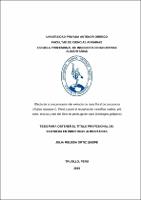Mostrar el registro sencillo del ítem
Efecto de la concentración del extracto de rama floral de zarzamora (rubus robustus c. presl.) sobre el recuento de mesófilos viables, ph, color, textura y olor del filete de pechuga de pavo (meleagris gallipavo).
| dc.contributor.advisor | Perez Azahuanche, Fredy Romel | |
| dc.contributor.author | Ortiz Quispe, Julia Melissa | |
| dc.creator | Ortiz Quispe, Julia Melissa | |
| dc.date.accessioned | 2019-09-16T12:56:57Z | |
| dc.date.available | 2019-09-16T12:56:57Z | |
| dc.date.issued | 2019 | |
| dc.identifier.uri | https://hdl.handle.net/20.500.12759/5412 | |
| dc.description.abstract | El objetivo de esta tesis fue determinar el efecto de tres extractos (1, 3 y 5%) de la rama floral de zarzamora, Rubus robustus C. Presl, sobre el recuento de mesófilos viables, pH, color, textura y olor del filete de pechuga de pavo, Meleagris gallipavo. El menor recuento de mesófilos se obtuvo con el extracto al 5%; el aumento de la concentración del extracto disminuyo el valor del pH del filete. Se aplicó la prueba de Levene modificada para determinar la homogeneidad de varianzas; P > 0,05; a continuación, el análisis de varianza para determinar el efecto significativo de la concentración del extracto sobre el recuento de mesófilos, pH, color, textura y olor; y finalmente, la prueba de Duncan para determinar el mejor tratamiento y Dunnet para la comparar cada uno de los tratamientos con el control. Todos los tratamientos tuvieron efecto significativo sobre mesófilos viables, pH, color, textura y olor. Para el color se midió en luminosidad (L*) y cromaticidad (a* y b*); en todos los tratamientos los filetes fueron opacos y teñidos verde y amarillo a diferencia del control que conservó su brillo y color rosáceo característico de la pechuga de pavo. La medición de la textura instrumental se produjo, con el extracto al 3%, que indicó mayor dureza y menor elasticidad en los filetes; en tanto que, los jueces semientrenados determinaron la mayor jugosidad en los filetes con el extracto al 5%. Para la evaluación sensorial del olor con todos los tratamientos, los jueces semientrenados indicaron que les “disgustaron muchísimo” frente al control. El mejor tratamiento se atribuyó al uso del extracto de zarzamora al 5%; por cuanto produjo el menor recuento de mesófilos viables, la menor variabilidad del pH. | es_PE |
| dc.description.abstract | The aim of this thesis was to determine the effect of three extracts (1, 3 and 5%) of the floral branch of blackberry, Rubus robustus C. Presl, on the count of viable mesophiles, pH, color, texture, and odor of the fillet of turkey breast, Meleagris gallipavo. The lowest mesophil count was obtained with the 5% extract; the increase in the concentration of the extract decreased the pH value of the fillet. The modified Levene test was applied to determine the homogeneity of variances (P > 0,05); then, the analysis of variance to determine the significant effect of the concentration of the extract on the count of mesophiles, pH, color, texture and odor; and finally, the Duncan test to determine the best treatment and Dunnet test to compare each of the treatments with the control. All treatments had a significant effect on viable mesophiles, pH, color, texture, and odor. For color, it was measured in luminosity (L *) and chromaticity (a * and b *); in all treatments the fillets were opaque and dyed green and yellow, unlike the control that conserved its brightness and pinkish color characteristic of the turkey breast. The measurement of the instrumental texture was carried out with the extract at 3%, which indicated greater hardness and lower elasticity in the fillets; whereas, the semitrainned judges determined the greater juiciness in the fillets with the 5% extract. For the sensory evaluation of the odor with treatments, the semitrainned judges indicated that they ““disliked a lot““ in front of the control. The best treatment was attributed to the use of 5% blackberry extract; because it produced the lowest count of viable mesophiles and the lowest pH variability. | en_US |
| dc.description.uri | Tesis | es_PE |
| dc.format | application/pdf | es_PE |
| dc.language.iso | spa | es_PE |
| dc.publisher | Universidad Privada Antenor Orrego - UPAO | es_PE |
| dc.relation.ispartofseries | T_ALIM_383 | |
| dc.rights | info:eu-repo/semantics/openAccess | es_PE |
| dc.source | Universidad Privada Antenor Orrego | es_PE |
| dc.source | Repositorio institucional - UPAO | es_PE |
| dc.subject | Rama Floral | es_PE |
| dc.subject | Zarzamora | es_PE |
| dc.title | Efecto de la concentración del extracto de rama floral de zarzamora (rubus robustus c. presl.) sobre el recuento de mesófilos viables, ph, color, textura y olor del filete de pechuga de pavo (meleagris gallipavo). | es_PE |
| dc.type | info:eu-repo/semantics/bachelorThesis | es_PE |
| thesis.degree.level | Título Profesional | es_PE |
| thesis.degree.grantor | Universidad Privada Antenor Orrego. Facultad de Ciencias Agrarias | es_PE |
| thesis.degree.name | Ingeniero en Industrias Alimentarias | es_PE |
| thesis.degree.discipline | Ingeniería en Industrias Alimentarias | es_PE |
Ficheros en el ítem
Este ítem aparece en la(s) siguiente(s) colección(es)
-
Industrias Alimentarias [145]

